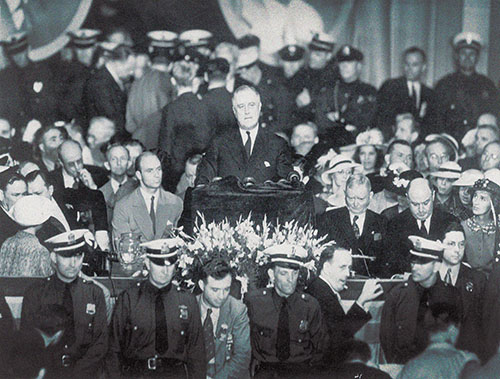
Including excerpts from his 1936 re-election campaign
By Nancy Spannaus
Oct. 17, 2024—The main purpose of this post is to encourage my readers to sign up for my upcoming class on FDR’s New Deal sponsored by Long Island University’s Hutton House program for lifetime learning. Here is the relevant information:
A NEW LOOK AT FDR’S NEW DEAL
Instructor: Nancy Spannaus
Ninety years ago, incoming President Franklin D. Roosevelt launched the New Deal, one of the most transformative economic programs the United States has ever seen. But what was the New Deal? Ask some Americans and they will tell you it was “socialist” big government and the source of infinite evils. Others praise it as a much-needed adoption of social welfare programs which saved our nation from disaster. In this class, public historian Nancy Spannaus will take a different approach. Drawing on her work on Alexander Hamilton, Spannaus will present FDR’s New Deal as a vital revival of Hamilton’s American System and make the case that his principles are still needed today.
Course# 94836
10 a.m. – 12 noon, EST on Zoom
Tuesdays, October 22 and 29
2 sessions
Fee: $62
To register: https://webapps3.liu.edu/HuttonHouse/?q=deal
Or call 516-299-2580
A Relevant Example
As some may question the relevance of FDR’s presidency to today, let me relay the following example.[1]
When President Franklin Roosevelt took the stage in Philadelphia in June 1936, to accept his re-nomination as the Democratic presidential candidate, he had a decision to make. Surely, he could choose to crow about the progress that had been made during his first four years—the millions of people employed, the re-opening of the banking system, the launching of major water projects, the saving of thousands of Americans from losing their homes, and much more.

But FDR did not dwell on his administration’s accomplishments. Knowing that millions of Americans were still suffering from Depression conditions, he chose to take aim at the major force blocking a full recovery – Wall Street’s “economic royalists.”
As was his wont, the President first located the current fight in our nation’s history.
In 1776 we sought freedom from the tyranny of a political autocracy—from the eighteenth century royalists who held special privileges from the crown. It was to perpetuate their privilege that they governed without the consent of the governed; that they denied the right of free assembly and free speech; that they restricted the worship of God; that they put the average man’s property and the average man’s life in pawn to the mercenaries of dynastic power; that they regimented the people.
And so it was to win freedom from the tyranny of political autocracy that the American Revolution was fought. That victory gave the business of governing into the hands of the average man, who won the right with his neighbors to make and order his own destiny through his own Government. Political tyranny was wiped out at Philadelphia on July 4, 1776.
But with the growth of the American economy, FDR continued, a new form of tyranny arose in the form of economic dynasties. The hereditary royalists of the British Empire were replaced by a small group with the financial power to exercise almost dictatorial control over people’s lives. As FDR said:
The royalists of the economic order have conceded that political freedom was the business of the Government, but they have maintained that economic slavery was nobody’s business. They granted that the Government could protect the citizen in his right to vote, but they denied that the Government could do anything to protect the citizen in his right to work and his right to live.
The royalists claim “we seek to overthrow the institutions of America,” FDR went on. “What they really complain of is that we seek to take away their power.” His message was: America’s commitment to end tyranny demands that we use our government to do so.

The conclusion of FDR’s acceptance speech is equally instructive, as well as in contrast to our general approach today. He emphasized that a debate over the role of government had raged over the previous four years. What we have learned, he said, is that the “greatest guide” is “moral principle,” specifically the commitment to “faith, hope, and charity.”
I leave it to you to read the speech itself, rather than attempt a further summary. But I can’t resist quoting one of his most memorable lines:
Governments can err, Presidents do make mistakes, but the immortal Dante tells us that divine justice weighs the sins of the cold-blooded and the sins of the warm-hearted in different scales.
Better the occasional faults of a Government that lives in a spirit of charity than the consistent omissions of a Government frozen in the ice of its own indifference.
“I welcome their hatred”
As the campaign went on, FDR only intensified his focus on the economic royalists who sought to derail the New Deal. His attitude is well summarized in this statement, made in a rally at Madison Square Garden on October 31.
Never before in all our history have these forces been so united against one candidate as they stand today. They are unanimous in their hate for me—and I welcome their hatred.
You can read this full speech here.
Learn more about the statesmanship of the last great representative of the American System of economics. Sign up today: https://webapps3.liu.edu/HuttonHouse/?q=deal
[1] Having posted almost 700 articles on this site over the last 7 years, it’s only natural, I suppose, that I don’t remember them all. I just noticed that I published the full text of this speech in the wake of the 2020 presidential nominating conventions, noting in particular the fact that Wall Street got a total pass in both. Have things really changed that much?
Related Posts
Tags: economic royalists, FDR, Franklin Roosevelt, Nancy Spannaus, New Deal







